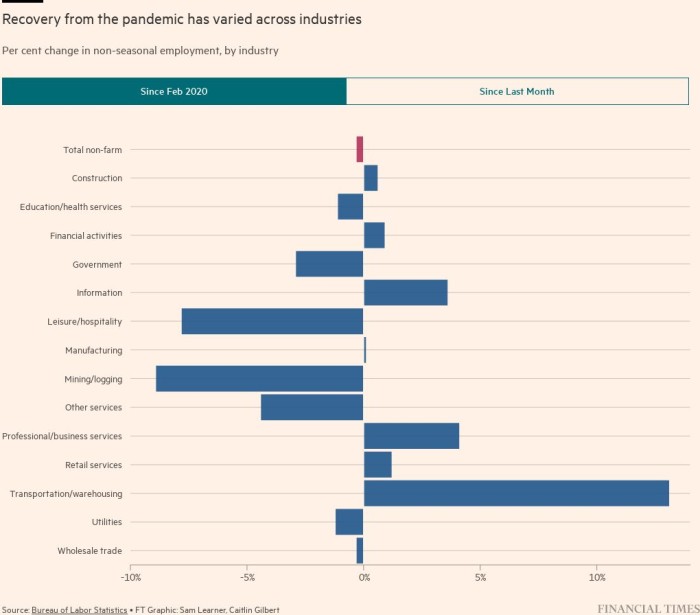[ad_1]
Red-hot labour demand stoked another strong month of US jobs gains, defying expectations for a sharper slowdown and giving the Federal Reserve greater leeway to continue raising interest rates to stamp out soaring inflation.
Non-farm payrolls grew by 372,000 in June, the Bureau of Labor Statistics reported on Friday, far above the 265,000 that economists had expected and just shy of the downwardly revised 384,000 positions created in May.
With these gains, the unemployment rate stabilised at its historically low level of 3.6 per cent, just above its pre-pandemic threshold.
The two-year Treasury yield, most sensitive to monetary policy changes, jumped by 0.1 percentage point to its highest level in two weeks on expectations the strong jobs figure would encourage aggressive Fed action.
Economists had widely expected monthly job creation to slow given the strength of the recovery and the fact that almost all of the jobs lost during the pandemic have been recouped.
Professional and business services jobs jumped by the most for the month, with 74,000 positions added. Employment in the leisure and hospitality sector rose by 67,000, helping to close a still 1.3mn gap for the sector compared to pre-pandemic levels.
Nearly 40,000 jobs were added to the transportation and warehousing sector with another roughly 30,000 positions created in the manufacturing space.
As June’s figures show, the labour market remains the bright spot of the world’s largest economy despite growing recession fears and concerns that American consumers are starting to tighten their purse strings as their pandemic savings dwindle.
“The strong 372,000 gain in non-farm payrolls in June appears to make a mockery of claims the economy is heading into, let alone already in, a recession,” said Andrew Hunter, senior US economist at Capital Economics.
In a statement released on Friday, president Joe Biden said the US is “uniquely well positioned” to tackle high inflation and other growth woes stemming from Russia’s invasion of Ukraine in light of the “historic strength” of the jobs market.
“No country is better positioned than America to bring down inflation, without giving up all of the economic gains we have made over the last 18 months,” he said.
Employers are still having to compete fiercely over a shrinking pool of new talent to fill a near-record number of job openings to keep up with strong consumer demand for goods and services. Lay-offs remain at historic lows and recent data show about 1.9 job openings for every unemployed person.
Average hourly earnings ticked up another 0.3 per cent in May, after a 0.4 per cent increase the previous period, and are now 5.1 per cent higher on a year-over-year basis.
Yet, the labour force participation rate, which tracks the share of Americans either employed or actively looking for work, dipped to 62.2 per cent as the labour force contracted by 353,000 people. That is more than one percentage point below levels seen before the start of the coronavirus pandemic.
With the Federal Reserve embarking on what is expected to be the most aggressive campaign to tighten monetary policy since the 1980s, economists fear the US jobs market is at serious risk, with unemployment likely to rise next year and into 2024, delivering a further hit to Biden’s popularity. However, his administration has said the slowdown in job creation is reflective of a transition to a “more sustainable pace of job growth”.
The US central bank has lifted its benchmark policy rate by 1.5 percentage points since March, having delivered the first 0.75 percentage point rate rise since 1994 last month.
Another jumbo adjustment is expected at its policy meeting at the end of the month. Policymakers are now aiming to move interest rates to about 3.5 per cent by year-end, a level that actively begins to constrain economic activity.
“[June’s jobs report] is going to give the Fed more comfort in their decision to march on ahead with higher rates, because the employment side of their mandate is fine,” said Gargi Chaudhuri, head of iShares investment strategy for the Americas at BlackRock. “The economy is still very strong.”
Minutes from the June meeting suggest officials have increasingly accepted that their efforts to quell the highest inflation in 40 years will require “some slowing in economic growth and tempering in labour market conditions”. Most have pencilled in the unemployment rate rising to 4.1 per cent in 2024, as core inflation drops to 2.3 per cent.
More pain may be necessary, economists warn, with many expecting a more severe economic downturn. Fed chair Jay Powell also recently conceded that a US recession is now “certainly a possibility”, but has maintained there are still pathways for the central bank to reduce inflation without causing widespread job losses.
[ad_2]
Source link




